R.1602
The roadbed
‘The damage caused by the passage of traffic is the financial Achilles heel of the railway’
The weight of a railway locomotive is shared among its wheels so that each carries a load of roughly 10 tonnes (figure 1). In turn, each wheel is supported by a contact area roughly a centimetre across, and if placed directly on the ground, it would sink. Fortunately, a steel rail will accept the load and also provide a smooth running surface, but the rails themselves need support to spread the load further and to keep them aligned accurately with the wheels under the pounding of heavy traffic. It is the function of the roadbed to hold everything together, and its construction and maintenance accounts for a sizeable proportion of the cost of railway operation. In its traditional form, the roadbed is a curious structure. Although meant to carry heavy loads, the base is made from loose stones that move slightly as each axle passes overhead. In recent decades, another kind of roadbed has emerged in the form of the concrete slab. It’s not yet certain how it will perform over the long run. In this Section we will see how both types behave and why they need careful attention.
Figure 1
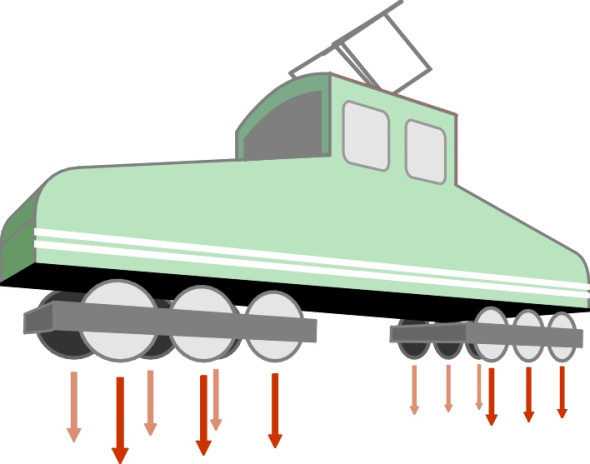
The conventional roadbed
Without reinforcement, natural soil cannot handle the loads imposed by a railway track. The problem is not simply a matter of strength. Soil, even a wet, slippery variety like saturated clay, will carry any burden we care to place on it; when confined in a rigid container it will withstand enormous pressure. If this were not so, the earth beneath our feet would have collapsed thousands of years ago under its own weight. The problem is that whenever there is an exit route, the soil will flow out of the way. If you stand on soft ground, the soil is liable to rotate, flowing downwards underneath your shoe and upwards around the sides as shown in figure 2. This is essentially a shear failure. The material has limited shear strength and therefore neighbouring masses of soil can slide over one another. In figure 2, the sliding occurs along a roughly cylindrical surface marked by the dotted line.
Figure 2

Spreading the load
There are two ways to get round this. The first applies to tall buildings. You can work out beforehand the weight of a skyscraper and dig a deep foundation so the weight of soil removed is roughly equal to the weight of the structure that replaces it. The pressure of the foundations resting on the soil will then be equal to the pressure previously exerted by the excavated material, so that as far as the ground underneath is concerned, nothing has changed. There is no ‘extra’ load to carry, and the building floats like a ship in deep water. The alternative is to accept that there will be an increase in the load carried by the soil, but to spread the increase over the widest possible area (figure 3). The soil can still fail by rotation, but the geometry forces a large body of soil to rotate. Since the larger body has a larger surface area along the plane of failure and the resistance is proportional to this surface area, it will carry a greater load.
Figure 3
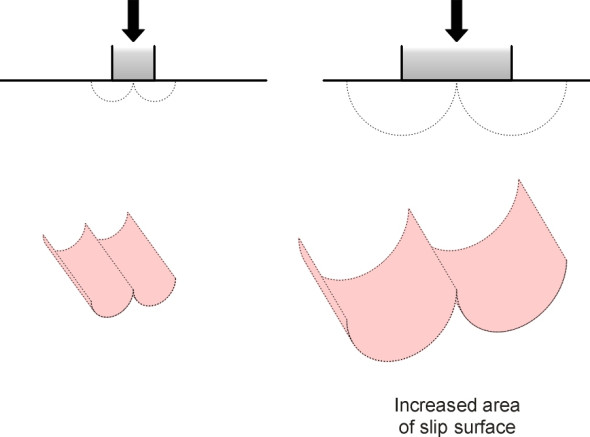
This is the technique used with roads and railways, although the method used to spread the load is different in either case. On a railway, each wheel is supported by a steel rail that is sufficiently rigid to spread the load over a length of a metre or so, transmitting it to a group of sleepers laid crosswise that spread the load further. If the wheel were positioned directly over a sleeper, about 40% of the load would pass directly into that sleeper, with just under a quarter going to each of its immediate neighbours [15], and the remainder to sleepers further away (figure 4). In turn, the sleepers are bedded on a layer of crushed stone called ballast\(\;\) that spreads the load further still across a width of around 2.7 m [24]. A conventional track, then, consists of three essential ingredients [1]: the rail, the sleepers, and the ballast (figure 5). Together they diffuse the wheel load so that the compressive pressure, which starts at a little under 1 GPa between the wheel and rail, is reduced in stages to a value around 40 kPa at the subgrade [4] [13], a reduction factor of roughly 8000 (figure 6).
Figure 4
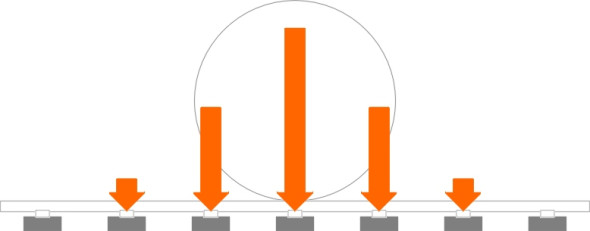
Figure 5
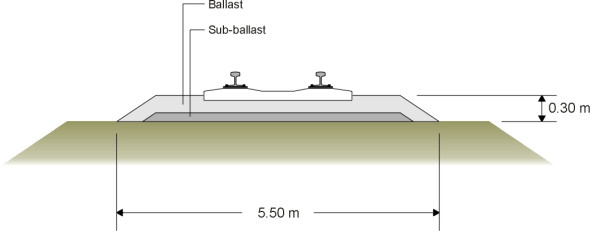
Figure 6
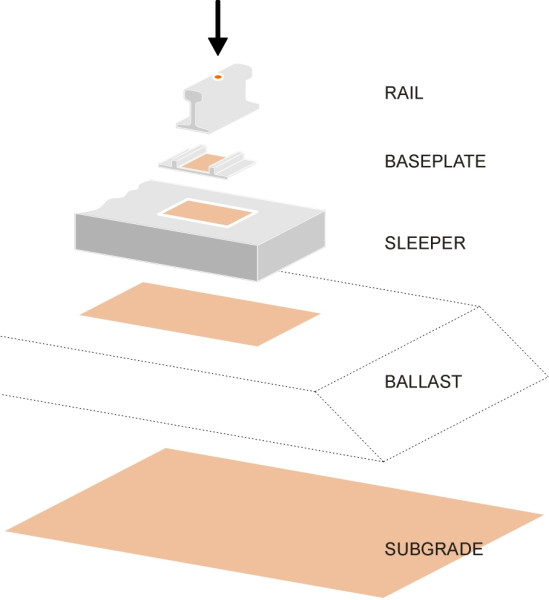
Sleepers
The word ‘sleeper’ dates from the 18th century and is used only in the UK. The American term is ‘tie’, the French ‘la traverse’, both of which express the fact that the beam holds the rails a fixed distance apart. In German it is ‘die Schwelle’. Thousands of sleepers, laid at equal intervals along the track, form an intermediate layer between the rails and the supporting ballast below. Many sleepers continue to be made from timber, for example beech, oak, or tropical azobé, impregnated with preservative under pressure. Typically 2600 mm long by 250 mm wide and 150 mm deep, a timber sleeper will last for between 25 and 50 years [17]. Because it is relatively flexible, a timber sleeper will distribute loads more evenly than a concrete sleeper but it can’t be used for high-speed operation because of its low weight: it can be displaced sideways by the wheels of a heavy locomotive at speed.
Figure 7
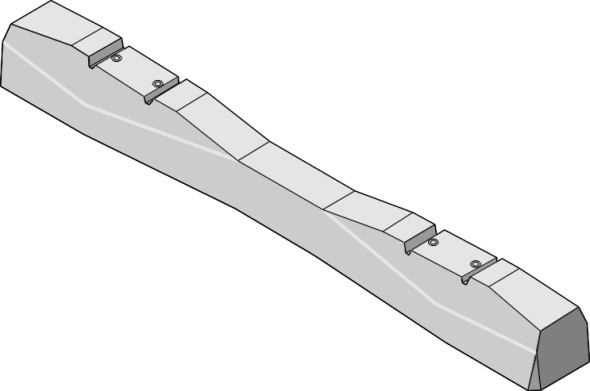
At one time, around 2.5 million timber sleepers were consumed per year in the UK alone [10], but nowadays concrete sleepers are preferred, typically spaced at intervals of 600 - 650 mm [14]. The most common type is cast as a single block (‘monobloc’) and pre-stressed by means of steel wires at a total tension of some 30 tonnes so it can resist large bending forces without cracking and letting in water (figure 7). Dimensions and other characteristics of monobloc sleepers vary among proprietary brands, and details can be found in [19]. When the block is cast, steel ‘chairs’ are set into the concrete to support the rails. The rail itself is separated from the chair by a rubber pad. The monobloc concrete sleeper is three times as heavy as a timber one, but being much harder, it doesn’t mould its surface to whatever it is resting on. Hence the block is supported by a relatively small number of contact points with the ballast underneath, and in spite of its greater weight is liable to move around under the course of many loading cycles. There is an alternative: a twin block assembly in which two concrete pads are linked by connecting bars of T or Y cross-section (figure 8). Such units (designated U41 and each weighing 260 kg) have been used on TGV lines [18]. They need a more substantial ballast layer than timber or monobloc and use more steel, but they provide greater transverse resistance because they have more vertical faces embedded in the ballast. Other materials such as steel and plastic are less widely used.
Figure 8
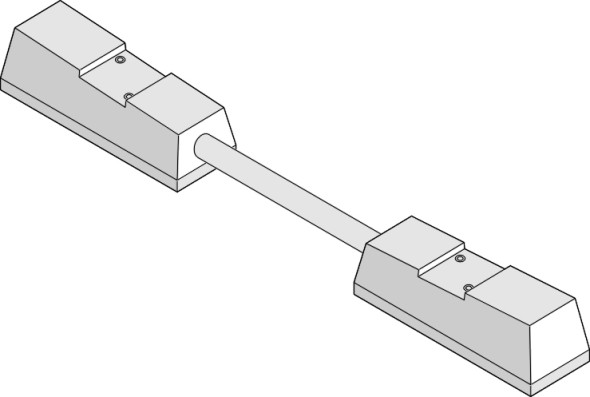
Ballast
The purpose of ballast is to spread the load evenly over the underlying soil. So why ballast? One might imagine that in order to resist the onslaught of a railway train at speed, the track needs a rigid foundation. But in practice, engineers prefer it to move a little under impact so it absorbs energy when a wheel crosses a gap in the rails or jolts against the side of the rail on a curve. This reduces the peak load and therefore reduces wear together with the likelihood of damage to the rail, and incidentally the friction among the particles damps down any vibrations that might be propagated along the rail, loosening fixings and generating unwelcome noise. So when a railway is built on solid rock, an absorbent foundation is essential [16]. Ballast also facilitates rainwater drainage and can be shifted relatively easily to make corrections to the track alignment.
Let’s probe a little further. Ballast is a curious material because it behaves differently from the solid materials such as steel and concrete that engineers normally use for structural purposes. It’s not rigid, but on the other hand it doesn’t flow like sand. The stones are jagged and they interlock so that a 400 mm deep layer can accept a heavy load and distribute it over the ground beneath. You can get a sense of this if you try to push a shovel into a pile of coal. Unless the pieces are smoothly rounded like marbles they are almost impossible to penetrate. The jagged profile is important, and therefore ballast is usually made by crushing rock and passing the fragments through a sieve. The individual pieces should be of broadly uniform size of the order of 5 cm in diameter.
About twenty years ago, it was discovered that over time, a horizontal stress will develop in a ballast layer as if it were being squeezed from all points of the compass towards the centre of the track. Provided nothing disturbs the granules, the stress remains locked inside the ballast and it seems to play an important role in maintaining the integrity of the layer as a structural unit under the pounding of heavy traffic. Where does it come from? Only in the last twenty years or so have scientists begun to study the interlocking process in granular materials such as coal and sugar: experiments have shown that when a load is applied it does not spread out uniformly into whatever is supporting the material from below [7]. Instead, it seeks out chains of granules that happen to form a natural arch. These carry a disproportionate part of the load while others carry less. For centuries, architects have used arches to carry heavy loads because the stones wedge together under pressure and cannot easily be dislodged. That is why in ancient ruins, the arches remain while the rest of the building has long since fallen down. This arching action could account for the compressive stress in a railway ballast layer, and incidentally, it could account for the way the ballast seems to lose its resistance after tamping (a process we’ll describe in a moment): the natural arches are broken up and it takes time for alternative load paths to develop as the material settles over the next few weeks.
But even when they have been compacted the stones won’t remain perfectly still. Like the particles within a solid material, they will deflect minutely under the impact of a wheel load, although the way they move is different: they grind together at their contact points and rearrange themselves into a more compact layer. Experiments with computer tomography have shown that when a stone moves, it settles slightly and makes contact with more neighbours but doesn’t usually rotate [12]. These tiny movements are what give ballast the ability to dissipate energy: like rubber, it is a visco-elastic material. But the grinding action means that the stone loses some of its sharp corners during use, and when limestone chippings grind against one another they form a powder that turns into slurry in wet weather. The slurry weakens the ballast by acting as a lubricant, and it is difficult to remove [11]. A hard stone such as granite or basalt is better.
So after it is laid, the ballast layer will become more compact and the track will settle under the action of traffic. It may also move from side to side, because ballast provides only limited resistance to sideways displacement of the sleepers, which tends to occur in places where owing to centrifugal force, train wheels press against the outer rail on curves. The effects are cumulative, and from time to time it is necessary to re-align the track and restore the rails to their original position. As we’ll describe later, the rails are lifted and ballast is tamped underneath each sleeper before the rails are replaced in their correct position. If the tamping were carried out evenly across the lower face, the sleeper would bend in the middle and produce tensile cracks in the upper face, and therefore as shown in figure 9, the ballast is packed more tightly underneath the rails [5].
Figure 9
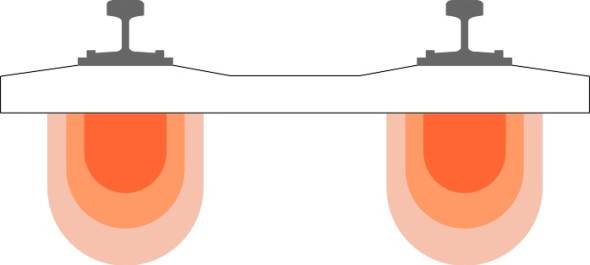
Figure 10

A track can resist sideways movement on a curve if the ballast is piled up to provide generous shoulders [1], with the depth increasing to around 0.5 m beyond the sleeper ends as shown in figure 10. Generous shoulders also reduce the risk of a straight track buckling in hot weather. But with the development of high-speed railways, other problems have emerged for which no-one has yet found a solution. High-speed trains leave an aerodynamic wake that can pluck individual chippings out of the surface layer. Once airborne, they can damage the underside of the vehicle, and occasionally a particle lands on the rail head where it is crushed by a passing wheel and scores the running surface. Mysteriously, on a high-speed track, the ballast that is laid on curved sections tends to migrate from the high end of each sleeper and pile up against the face of the inner rail. The cause is not known for certain, but one imagines that the energy injected into the structure when a train passes at speed will from time to time loosen granules at the surface, which under repeated track loading will roll down the slope until trapped by the rail.
Maintenance
Since a conventional railway track is built essentially on loose material, it’s not surprising that it settles gradually over time with the passage of traffic and must be re-aligned at regular intervals. And the quality of the ballast deteriorates. The rate of deterioration of a railway roadbed and the rate of deterioration of a highway follow a broadly similar pattern. The key is not so much age as traffic. The lifetime of a road is reduced with the passage of every vehicle axle and the same applies to a railway: damage is cumulative and the contribution made by an axle is extremely sensitive to the wheel load. There is no single formula that adequately covers all circumstances, but as a rough idea you could take the damage as proportional to the wheel load raised to the fourth power (see Section C1602), so that when the wheel load doubles, the damage increases by a factor of sixteen.
Track maintenance is expensive. It is carried out under time pressure in a closely confined working space using a skilled workforce and purpose-built plant and equipment. The alignment can be checked from a moving vehicle using laser measuring equipment, but most of the work itself is carried out at night so as not to disrupt the railway timetable. A mechanised train is brought to the site that can perform different functions such as lifting the track, cleaning the ballast and re-aligning the rails as a continuous process under computer guidance. We won’t go into detail but a comprehensive account can be found in [3]. Here, we’ll concentrate on the ballast.
Figure 11
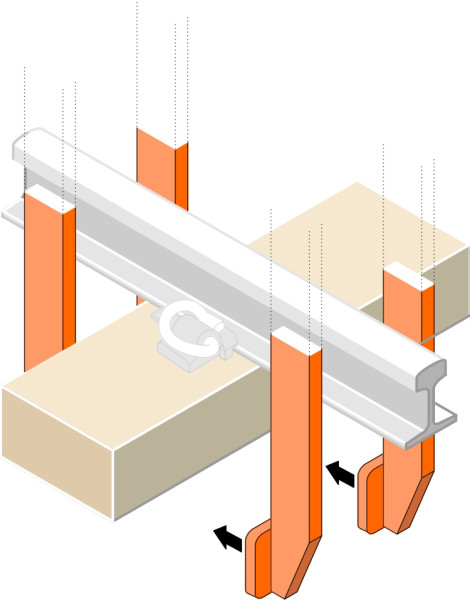
The key operation is tamping. First, the track is lifted a few centimetres clear of the ballast surface, then a specially designed tamping machine inserts steel forks vertically into the ballast and squeezes the material under each sleeper to raise the surface level (figure 11). This disturbs the interlocking geometry of the ballast stones, so the forks also vibrate at a frequency of 30 - 40 Hz to shake them down into a more compact arrangement. Even so, the ballast loses some of its former stability and the track has less resistance to sideways buckling when the temperature peaks in the middle of the day [20]. Also it loses some of its stiffness in the vertical direction, and will undergo large deflections under the impact of a heavy wheel load. Once back in service, the track will stabilise gradually [2]. According to one empirical formula, the settlement is somewhere between 5 and 15 mm with the passage of about 2 million tonnes of traffic. Even on a busy line this can take several weeks [21].
Water in the ballast layer can damage a railway track in at least three ways. First, it will pump through the interstices when it is momentarily compressed under load so that it dislodges granules and weakens the interlocking geometry. Second, it can freeze during a cold spell and cause ‘frost heave’ in the track bed, a process not unlike frost heave in a highway pavement (See Section C1602). Finally, water carries contaminants such as clay, organic matter or limestone grit, all of which will degrade the load-bearing capacity of the ballast layer. Such conditions are not always easy to diagnose, although ground-penetrating radar can assess the ballast thickness and detect the presence of water. Contaminated ballast must be removed, cleaned and put back at regular intervals. This is done by machine, without actually dismantling the rails. The material is ferried to the cleaning plant in hopper wagons and after being returned to the working area, it is are dropped in heaps onto the bed and levelled by a built-in scraper or a separate plough before the rails are lowered again and the ballast is tamped into a compact mass. On the other hand, worn ballast is scrapped and replaced with fresh material.
Concrete slab track
Because the ballast is not quite rigid, the alignment of any railway track will deteriorate over time. Having held to the concept for generations, engineers are now turning to something very different: the concrete slab. As you might imagine, the alignment of a concrete slab is more stable and the material is structurally rigid, so the track as a whole is less resilient. However, experiments since the early 1970s [9] have shown that the loss of resilience can be partly compensated by flexible pads inserted between the rail and the slab. Although slab track costs about twice as much to lay, it will last for 50 or 60 years, and the maintenance cost - a perpetual drain on the resources of any railway company - is only a fraction of the cost of maintaining ballasted track, perhaps a third or less. It is particularly useful in tunnels, where the confined space makes maintenance difficult, but in Germany, the Netherlands and Japan, it is being introduced on a much wider scale.
Alternative configurations
A slab can be made from three different types of material (reinforced concrete, pre-stressed concrete, and asphalt), and there are several ways of fixing the rails. A comprehensive account of the various alternatives can be found in [6]. The most popular approach is to construct the slab first then lay the sleepers on top of the slab on a rubber mat. A variation of this method is used in the Channel Tunnel, where each sleeper is split into two short segments. Each segment is insulated with a rubber pad set in a rigid plastic boot and embedded in the slab. Several alternatives have been pioneered in Germany, and in one of the early variants, the slab is shaped like a trough with a 180 mm thick reinforced concrete base. Sleepers are placed in the trough, which is then filled with concrete to secure them in place. Alternatively, the sleepers are wired in position and the whole concrete slab cast around them. In Japan, the slab is prefabricated in short sections only 160 mm thick and pre-stressed so they can be laid very quickly on a 400 mm thick vibration-absorbing asphalt roadbed. Cylindrical plugs cast into the roadbed prevent the slabs from sliding out of position. But the most interesting development is one in which there are no sleepers at all: the rails are embedded in slots cast into the slab, separated from the concrete by an insulating layer of epoxy compound that holds them in position and absorbs some of the vibration that would otherwise lead to a rough and noisy ride (figure 12).
Figure 12
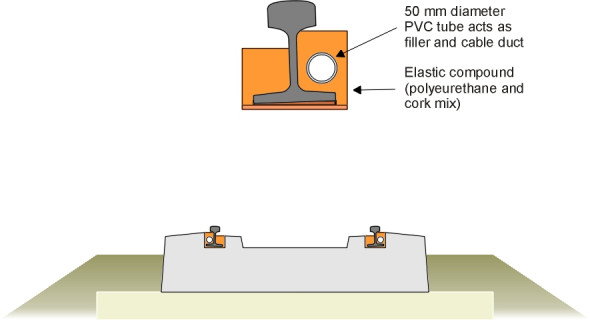
Some advantages and disadvantages
The main advantage of a slab track is that it doesn’t need much maintenance. It is also safer in the sense that if a rail breaks, it is less likely to cause a derailment because the rail fixings are embedded in the slab, and have less freedom of movement than sleepers on a ballast layer. However there are two main disadvantages, and a third one that we shall leave until later. First, a slab foundation is not easily adjustable in the same way that ballast is adjustable. If for any reason the underlying soil is weaker in some places than in others, over time there will be differential settlement that distorts the vertical profile, and it is difficult to apply a correction that will restore the rails to their original level. Secondly, assuming the soil has adequate strength, a slab foundation is stiffer than ballast, and the rail fastenings have to be more flexible to reduce wheel impacts to an acceptable level. The rail then vibrates over a longer length [8]. Hence the vehicles travelling on slab track make more noise, and a greater proportion of the noise is reflected into the surroundings by the smooth concrete surface. The result is an overall increase in noise emissions of the order of 3 - 5 dB [23].
Conclusion
The relative merits of concrete slab track and conventional ballasted track are still being tested, and it may be some years before there is a clear outcome. We don’t know what will happen in fifty years time, say, when the concrete slab reaches the end of its life. Replacing ballast is a routine job that can be done at night by machines that temporarily lift the track clear in one piece while the worn-out granules are removed and replaced by fresh material. The track is then lowered back into place and the ballast tamped by machine so that normal service is resumed within hours. But a concrete slab can’t be treated in the same way. Firstly, the rail fixings are embedded in the concrete so the track can’t easily be detached, and secondly, the slab must be broken up before it can be removed. No-one is sure how this can be done without closing the track for several weeks.